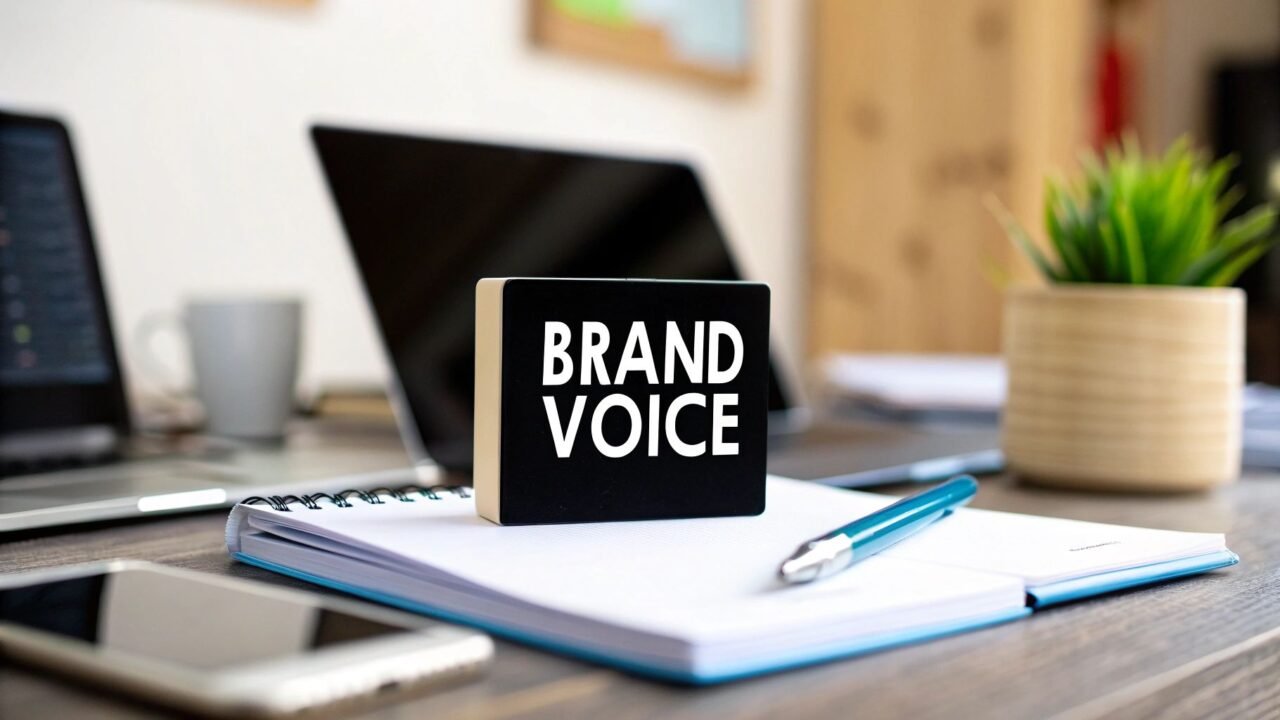What Makes a Brand Voice Guide Actually Matter?

Let’s be honest: many brand voice guides gather dust. This raises a crucial question: what’s the difference between a helpful guide and one that’s forgotten? The answer lies in recognizing its power as a valuable business asset. This section explores why an effective brand voice guide is essential for businesses aiming to build lasting customer relationships.
A well-crafted brand voice guide is more than a document; it’s the bedrock of your brand’s communication. It guarantees that every interaction, from social media to email, reflects a consistent personality. This consistency is crucial for establishing trust and brand recognition.
Think about brands you love. Their communication, no matter the platform, has a distinct feel you instantly recognize. This familiarity builds trust and loyalty. This is directly linked to the importance of a strong brand voice, creating a consistent identity across all channels. A strong brand voice can increase brand recognition by up to 80% and boost customer loyalty by 75% with consistent application. Learn more about the importance of brand voice here: https://sproutsocial.com/insights/brand-voice/
Brand Voice Guide vs. Style Guide
It’s important to distinguish a brand voice guide from a style guide. A style guide deals with the mechanics of writing (grammar, punctuation, formatting). A brand voice guide defines the personality and tone. The style guide ensures your content is correct; the voice guide ensures it’s engaging and on-brand.
Think of it this way: the style guide is the grammar teacher, ensuring correct sentences. The voice guide is the acting coach, helping you deliver lines with the right emotion and impact.
Why Cross-Team Consistency Matters
Using your brand voice consistently across all teams is vital for a unified brand experience. Imagine a customer interacting with marketing on social media, then contacting customer support and experiencing a completely different tone. This inconsistency can damage trust and create confusion.
A shared brand voice guide empowers every team member to communicate with the same personality. This reinforces brand identity and creates a seamless customer experience. This leads to improved brand recall and a more positive overall perception of your business.
Creating Emotional Connections
In a market flooded with generic messaging, a distinct brand voice helps you stand out and connect with your audience on a deeper level. Infusing your communication with personality and emotion creates a memorable and engaging experience.
This resonates with customers seeking authentic brand connections. A well-defined brand voice allows your brand to tell its story in a unique way, setting it apart from competitors and fostering stronger loyalty.
Real Business Impact of a Distinctive Brand Voice
A defined brand voice is more than just marketing jargon. It’s a powerful tool that can significantly impact your bottom line. This means moving beyond abstract concepts and focusing on measurable results. This section explores how a consistent brand voice translates into tangible business outcomes, driving engagement, retention, and conversion rates.
Measurable Results of Voice Consistency
Developing a strong brand voice significantly impacts key performance indicators. Businesses with a consistent voice often see higher engagement on social media platforms like Twitter. This increased interaction translates into greater brand visibility and reach.
A recognizable voice fosters trust and loyalty, directly contributing to improved customer retention rates. Ultimately, this strengthened relationship with customers can lead to higher conversion rates.
Transforming Market Position Through Voice
Consider how startups disrupt established markets by projecting a fresh, innovative voice. This distinct personality helps them cut through the noise and resonate with target audiences.
Even established companies can leverage voice refinement to reconnect with evolving customer preferences. By adapting their communication style, they can maintain relevance and strengthen their market position. This demonstrates how a well-defined brand voice can be a catalyst for growth and market leadership.
Consistency in brand voice is crucial for maintaining a strong brand identity. Brands like Waze have successfully implemented consistent tones across different platforms, from navigational narrations to ad partner guidelines. This consistency helps build trust and recognition with the audience. Explore this topic further: Creating a Brand Voice Guide with Great Examples.
The Power of Emotional Resonance
Certain voice elements create stronger emotional connections with consumers. Consider incorporating qualities such as:
- Humor
- Empathy
- Authority
These qualities resonate deeply with audiences, building a sense of connection and trust. A well-crafted brand voice can transform casual consumers into loyal brand advocates.
Translating Resonance to Tangible Outcomes
This emotional resonance isn’t just a feel-good factor; it directly impacts business outcomes. A brand that evokes trust through its voice is more likely to convert leads into paying customers.
A voice that fosters a sense of community can drive customer engagement and advocacy. This ultimately translates into increased sales, improved customer lifetime value, and sustained business growth.
Creating Your Brand Voice Guide From Scratch
Stop guessing about your brand’s ideal sound. A well-crafted brand voice guide provides a roadmap for consistent and impactful communication. This guide walks you through a proven process, starting with understanding your audience.
Know Your Audience
Understanding your target audience is crucial. Consider their preferred language, values, pain points, and aspirations. For example, informal language and slang might resonate with Gen Z, while a professional audience likely prefers a more formal tone. This foundational knowledge informs the tone and style that will effectively connect with your ideal customer.
Uncover Your Voice Through Existing Materials
Examine your existing marketing materials, website content, and customer service interactions. Look for patterns in the language used. Do you see a consistent tone or style? Analyzing existing materials can reveal the underlying voice already present within your brand. This exercise provides a starting point for definition and refinement.
Practical Frameworks for Defining Your Voice
Various frameworks exist for identifying voice attributes. Considering personality traits is an effective approach. Is your brand friendly, authoritative, innovative, or humorous? Choosing 3-5 core attributes helps define your brand’s communication personality. These attributes offer clear direction for shaping your brand voice.
To illustrate, Canva’s mission to empower everyone in design aligns with its friendly and encouraging brand voice. This is reflected in its social media content and user interface. Developing a brand voice guide involves several key steps, including defining the audience, reviewing company literature, drafting guidelines, user testing, and circulating the finalized guide. Discover further insights on defining a brand voice here.
Testing and Refinement
After drafting your brand voice guidelines, test them with real users. Gather feedback on their perception of the voice. Does it resonate with the target audience? Does it reflect the brand’s personality and values? User feedback is essential for refining the guide and ensuring effectiveness.
Developing Tone Variations
While your brand voice should remain consistent, the tone can adapt to different contexts. A casual, playful tone might suit social media, while a more formal tone is appropriate for business communications.
Consider these scenarios:
- Social Media: A friendly, engaging tone encourages interaction.
- Email Marketing: Adapt the tone to the campaign goal, whether promotional, educational, or transactional.
- Customer Service: Prioritize empathy and helpfulness in customer interactions.
- Formal Communications: Maintain a professional and respectful tone.
Documenting Your Brand Voice Guide
A usable brand voice guide should be a living, easily accessible document that everyone in the organization understands. Use the following structure:
- Mission Statement: Articulate your brand’s purpose and values.
- Personality Traits: List the 3-5 core attributes defining your brand’s personality.
- Tone Variations: Provide examples of your voice across different platforms and communication types.
- Do’s and Don’ts: Offer specific language examples that align with and deviate from your brand voice.
- Real-World Examples: Showcase successful examples of your brand voice in action.
This structured approach transforms the guide into a practical tool for maintaining consistency.
The following table outlines the brand voice development process:
To better understand the process of developing a brand voice, let’s take a look at the table below. It offers a step-by-step breakdown, highlighting key activities and outcomes at each stage.
Brand Voice Development Process
| Development Stage | Key Activities | Expected Outcomes | Timeline |
|---|---|---|---|
| Audience Analysis | Research target audience demographics, psychographics, and online behavior. | Define ideal customer profile and understand communication preferences. | 1-2 Weeks |
| Existing Material Review | Analyze current marketing materials, website content, and customer interactions. | Identify existing voice patterns and potential inconsistencies. | 1 Week |
| Voice Attribute Definition | Brainstorm and select 3-5 core personality traits that best represent the brand. | Create a clear definition of the brand’s desired voice and personality. | 2 Weeks |
| Guideline Drafting | Develop detailed guidelines outlining tone variations, do’s and don’ts, and real-world examples. | Produce a working draft of the brand voice guide. | 2-3 Weeks |
| User Testing | Gather feedback from target audience members on the perceived voice and its effectiveness. | Refine the guide based on user feedback and ensure resonance. | 2 Weeks |
| Finalization & Distribution | Finalize the brand voice guide and distribute it across the organization. | Equip the team with a practical tool for consistent communication. | 1 Week |
This table summarizes the key stages involved in creating a comprehensive brand voice guide, from initial audience research to finalization and distribution. Each stage has specific activities and expected outcomes that contribute to the overall effectiveness of the guide.

By following these steps, you can create a brand voice guide that empowers your team to communicate effectively and authentically, strengthening your brand identity and resonating with your target audience.
Essential Elements That Make Brand Voice Guides Usable
Most brand voice guides fail not because of their content, but because they’re impractical. A beautiful document sitting unused on a server helps no one. This section explores the elements of a truly effective brand voice guide – one that teams actually use daily.
Clear Personality Profiles: Beyond Buzzwords
A personality profile goes beyond simply listing adjectives. It paints a vivid picture of your brand as a person. Imagine your brand walking into a room. How do they carry themselves? What kind of energy do they exude?
Instead of just stating “friendly,” describe how that friendliness manifests. Are they quick with a joke? Do they offer a warm, welcoming smile? This depth of detail brings the personality to life, making it easier for writers to embody the voice.
Actionable Tone Variation Charts
Your brand voice needs nuance. While the core personality remains constant, the tone adapts to different contexts. A tone variation chart helps writers understand these shifts.
This isn’t just about formal vs. informal. Consider the emotional spectrum. When are you celebratory? When are you empathetic? When do you need to project authority? A well-structured chart provides clear examples for each scenario. For example:
| Context | Tone | Example |
|---|---|---|
| Social Media | Playful, Engaging | “Just dropped a new blog post! 🔥 Check it out!” |
| Customer Support | Empathetic, Helpful | “We understand your frustration. Let’s see how we can fix this.” |
| Press Release | Formal, Factual | “[Company] announces the release of its latest product.” |
This structured approach empowers writers to adapt the voice without losing the core personality.
Specific Language Examples: Do’s and Don’ts
Abstract descriptions are rarely helpful. Writers need concrete examples. A strong brand voice guide provides clear do’s and don’ts with specific language examples.
Instead of stating “avoid jargon,” show what that means. Provide side-by-side comparisons of jargon-heavy phrases and their clear, concise alternatives. This clarifies expectations and helps writers internalize the brand’s linguistic preferences.
Guiding Without Restricting Creativity
A brand voice guide shouldn’t stifle creativity; it should empower it. The goal isn’t to create robotic writers, but to provide a framework for authentic expression. Think of it as guardrails, not a straitjacket.
A good guide encourages writers to explore the nuances of the brand voice while staying within defined boundaries. This balance fosters consistent messaging while allowing for individual flair.
Structure and Usability: Making It Accessible
A comprehensive guide is useless if it’s difficult to navigate. Successful companies structure their brand voice guides for easy access. Consider these best practices:
- Clear Table of Contents: Allow writers to quickly find the information they need.
- Searchable Document: Enable keyword searches for specific terms or scenarios.
- Visual Hierarchy: Use headings, subheadings, and bullet points to break up content.
- Regular Updates: Keep the guide current and relevant as your brand evolves.
These structural elements transform the brand voice guide from a static document into a dynamic tool that supports consistent and effective communication. By prioritizing usability, you ensure the guide becomes a valuable resource that writers actually want to use. A well-structured, accessible brand voice guide empowers your team to create content that resonates with your audience and strengthens your brand. This clear, usable guide fosters consistency and ensures your brand speaks with one clear, engaging voice across all platforms.
Measuring If Your Brand Voice Is Actually Working

Developing a strong brand voice is essential for connecting with your audience. But how do you know if it’s actually working? This section offers a practical guide to measuring the effectiveness of your brand voice. We’ll explore how to track performance and gather valuable feedback for ongoing refinement.
Establishing Meaningful Baselines
Before launching your brand voice, establish baselines for key performance indicators (KPIs). These could include website engagement metrics like bounce rate and time on page, social media engagement (likes, shares, comments), and customer satisfaction scores. This initial data creates a benchmark to measure the impact of your brand voice strategy.
For example, if your average time on page is currently one minute, track how it changes after implementing your new brand voice guidelines. This direct comparison reveals whether the changes positively influence audience behavior.
Tracking Quantitative Data
Once your brand voice is live, consistently monitor relevant data points. Website analytics, social media insights, and customer service data provide valuable quantitative feedback. Don’t forget to track conversions, such as newsletter sign-ups and product purchases.
These concrete numbers offer evidence of your brand voice’s impact on your business goals. Focus on data that correlates with business objectives. This provides more insight than vanity metrics like follower count. It helps demonstrate the real value of your brand voice strategy. Analyzing data and metrics are important to assess brand voice effectiveness. Avinash Kaushik, author of Web Analytics: An Hour a Day, emphasizes tracking behavior data, outcomes, and user experience metrics, especially for website interactions. For more on this, find detailed statistics here.
Gathering Qualitative Feedback
While quantitative data is important, don’t underestimate the value of qualitative feedback. Surveys, focus groups, and social listening provide insights into how your audience perceives your brand voice.
Social listening, for instance, can uncover conversations about your brand. It shows how people respond to your tone and messaging. This qualitative data provides valuable context for understanding your brand voice’s overall impact.
A/B Testing and Continuous Improvement
A/B testing is a powerful tool for refining your brand voice. Test different messaging versions and see which resonates best. Experiment with varied tones or language in social media posts or email marketing campaigns. However, avoid chasing short-lived trends that don’t align with your core brand identity.
Through consistent measurement, analysis, and adaptation, your brand voice becomes a dynamic asset. It strengthens audience connection and drives business results. This continuous improvement process ensures your brand voice remains relevant and impactful.
Getting Everyone On Board With Your Brand Voice Guide
Creating a comprehensive brand voice guide is a significant step. However, its real power comes from its implementation across your organization. A guide sitting unused won’t help your brand. This section explores effective ways to introduce and integrate your brand voice guide, ensuring company-wide adoption and consistent use.
Training for Different Team Roles
Effective use requires specific training for various teams. Content creators need detailed guidance on incorporating voice nuances into their work. Customer service representatives need training on expressing the brand voice while handling customer inquiries.
For example, run workshops showing how the brand voice translates into customer service scripts and email templates. This practical approach ensures consistency across different communication points.
Quick-Reference Tools and Resources
Create resources that simplify using the brand voice. Design a quick-reference sheet listing key do’s and don’ts. Consider building interactive online modules with real-world examples and quizzes to reinforce learning.
These resources empower team members to apply the brand voice accurately in their everyday work. They also reduce reliance on longer documents and encourage consistent brand expression.
Securing Executive Buy-In
Executive support is essential for successful implementation. Make a strong case highlighting the advantages of a consistent brand voice. Explain how it reinforces brand identity, improves the customer experience, and contributes to business growth.
Leadership buy-in not only secures necessary resources but also shows the importance of brand voice consistency across the company. Executive support creates a company culture that prioritizes brand-focused communication.
Addressing Resistance to Change
Introducing a new brand voice guide may encounter some resistance. Some team members might be accustomed to existing methods. Others might view it as an additional task. Address these concerns proactively.
Explain the reasons behind the change clearly and provide ample training and support. Share success stories from other companies and demonstrate how a consistent voice has positive results. This open communication fosters acceptance across the organization.
Establishing Accountability
Implementing a brand voice guide doesn’t mean creating unnecessary bureaucracy. The aim is consistency, not inflexibility. Establish clear responsibility for maintaining brand voice consistency without hindering creativity or slowing down content production.
Integrate the brand voice guide into existing workflows and editorial processes. Establish clear guidelines for content approval and review. This organized approach promotes consistency while streamlining content development.
To further illustrate how to integrate a brand voice across different departments, consider the following table:
To help visualize how different departments can implement the brand voice guide, the following table provides examples and specific considerations.
Brand Voice Implementation Across Departments
A comparison of how different departments should apply the brand voice guide with specific considerations and examples for each team.
| Department | Key Applications | Common Challenges | Success Strategies |
|---|---|---|---|
| Marketing | Website copy, social media posts, advertisements | Maintaining consistency across multiple channels | Create detailed style guides and templates for each platform |
| Customer Service | Email responses, phone scripts, live chat interactions | Balancing brand voice with empathy and individual customer needs | Develop specific scripts and training modules for handling various customer scenarios |
| Sales | Presentations, proposals, client communication | Adapting the brand voice for individual client personalities | Create a flexible framework that allows for personalized communication while adhering to core brand values |
| Product Development | Product descriptions, user manuals, in-app messaging | Integrating brand voice into technical content | Collaborate closely with marketing to ensure consistent terminology and tone |
| Human Resources | Job postings, internal communications, employee handbooks | Maintaining a professional yet engaging tone | Develop a specific internal brand voice guide that reflects company culture |
This table outlines key considerations for each department when implementing the brand voice. By tailoring the approach to each team’s specific needs and challenges, you can ensure consistent brand expression across the organization.
Fostering a Culture of Consistency
Successful implementation relies on building a culture of consistency. The brand voice should become a core element of your company’s identity, reflected in every interaction, internal and external.
Regularly review and update the brand voice guide as your brand evolves. Provide ongoing training and support to emphasize its importance. Recognize achievements and acknowledge team members who effectively use the brand voice. This promotes a culture of brand ownership and ensures your brand’s message is clear and compelling.
Brand Voice Success Stories: What Actually Worked

A strong brand voice can significantly impact a company’s success. This section explores real-world examples of businesses that have effectively used their brand voice to achieve remarkable results. We’ll look at how these organizations identified their unique voice, documented it, and overcame implementation hurdles.
Mailchimp: A Case Study in Playful Professionalism
Mailchimp, the email marketing platform, expertly balances professionalism with a dash of quirky humor. This unique blend creates a memorable and engaging user experience. Their voice shines through in their website copy, marketing materials, and even error messages, resulting in a consistent and enjoyable brand experience.
For instance, their mascot, Freddie the Chimp, injects a playful element into an otherwise technical product. This distinct personality helps them stand out in a competitive marketplace. Mailchimp’s success demonstrates the power of a distinctive brand voice to elevate the user experience and cultivate a loyal following.
Dove: Authenticity and Empowerment
Dove, the personal care brand, has built its success on a brand voice rooted in authenticity and female empowerment. They’ve shifted away from traditional beauty standards, embracing a message of real beauty and self-acceptance. This resonates deeply with their target demographic.
Campaigns like the “Real Beauty Sketches” focus on promoting a positive body image and challenging conventional beauty norms. Dove’s commitment to this message is clear in all their communications, making their brand voice more than just marketing – it’s a core value. This authenticity has cemented their position as a leader in the personal care industry.
Innocent Drinks: Quirky and Engaging
Innocent Drinks, known for its smoothies and juices, uses a playful, quirky, and often humorous brand voice. Their packaging copy is full of lighthearted jokes and engaging stories. This unique personality sets them apart on store shelves.
This voice extends to their social media presence, where they connect with followers in a friendly and informal way. Innocent Drinks successfully uses humor and lightheartedness to engage with their audience, fostering a positive and memorable brand experience. This approach has undoubtedly contributed to their widespread appeal.
Learning From Success: Key Takeaways
These brand voice success stories offer several important lessons. First, authenticity is crucial. Your brand voice should reflect your company’s core values and resonate with your target audience.
Second, consistency is essential. Your brand voice should be evident across all communication channels to create a unified brand experience. Companies like Zendesk have successfully implemented brand voice guides that reflect their core values, ensuring every interaction—from customer service to marketing—aligns with their mission to be honest, empathetic, and fair. By defining a brand voice, businesses can differentiate themselves in a crowded market and foster lasting customer relationships. Find more statistics here: https://sproutsocial.com/insights/brand-voice/
Finally, don’t be afraid to stand out. A unique and memorable brand voice can help you cut through the noise in a competitive market. These examples show how a well-defined and consistently implemented brand voice can significantly contribute to brand growth and market leadership. Are you ready to transform your brand’s voice and reach its full potential? Personeur specializes in crafting distinct and impactful brand identities for entrepreneurs, coaches, and consultants. We empower you to stand out, attract opportunities, and establish lasting authority. Visit Personeur today to learn more.

